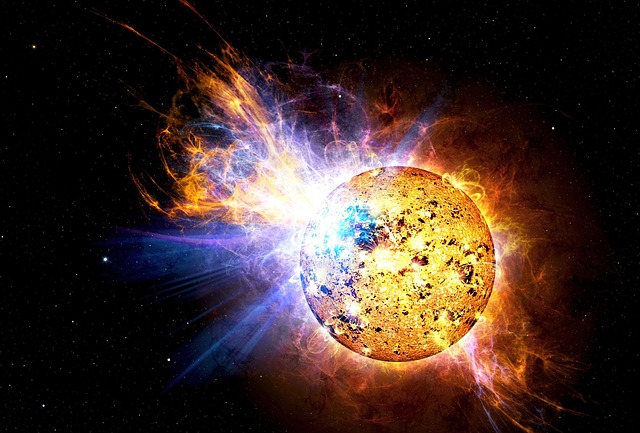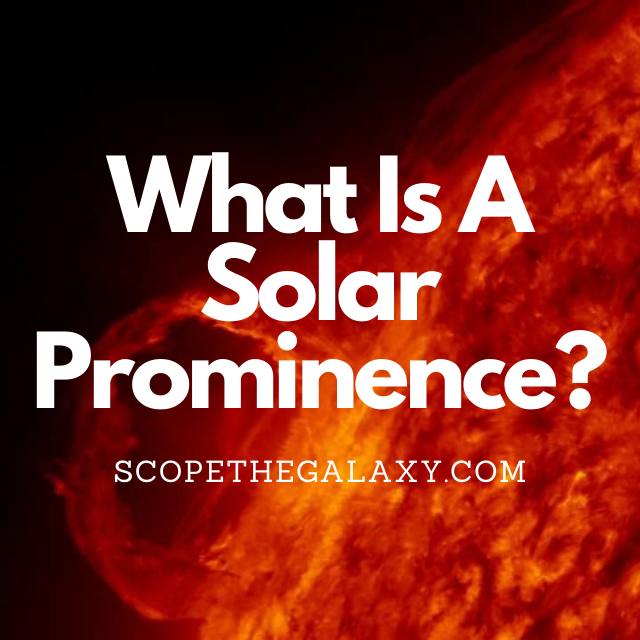*This post may contain affiliate links. This means we may make a commission if you purchase an item using one of our links*
A solar prominence is a sizeable loop-shaped structure that sits at the edge of the Sun and stands out against the dark backdrop of space. Though they appear bright, they are far cooler than the plasma surrounding them. The Sun’s magnetic field shapes these structures, which remain anchored to the photosphere; still, they stretch thousands of kilometers into space.
Continue reading to find out how solar prominences form, how often they occur, and what differentiates them from solar flares.
How Does A Solar Prominence Form?
Table of Contents
The cause of a solar prominence is still largely unknown in scientific circles, though we associate them with sunspot groups and thus, see a correlation with the solar cycle.
A prominence is a thick cloud of ionized gas that projects from the Sun’s chromosphere (the lowest layer of the solar atmosphere) into the corona (the outermost region). These entities are one of the Sun’s most significant individual magnetic features and often extend thousands of kilometers into space, though they remain anchored to the Sun.
While the exact causes are hard to distinguish, their formation likely involves the magnetic fields of the Sun, forming from a powerful gas surge that bursts out of this solar body. These prominences possess great variances in shape, size, and motion.
Scientists classify prominences into two distinct types: active and quiescent. An active prominence erupts quickly and lasts only minutes to hours, whereas a quiescent prominence builds up more slowly and may still be visible several months after it first emerges.
A prominence can appear as a flame-colored projection or “dark ribbons” known as filaments. The main ingredient of these red loops is plasma, a mixture of hydrogen and helium particles that carry an electric charge and create a hot gassy substance.
This plasma mix travels the looping pathways of the Sun’s magnetic fields, which the Sun’s internal dynamo creates. And the complex magnetic field of the Sun provides a prominence with its distinctive looping structure.
While the exact formation method is unknown, scientists have proposed a couple of intriguing theories. In 1994, Rust ; Kumar suggested that the cause could be a flux tube possessing an internal twist, which rises from the convection zone and emerges from the solar surface with just the right observational parameters. Lites et al. later supported and modeled this theory.
How Often Do Solar Prominences Occur?

Solar prominences occur frequently. They only take a day to form and can persist for several weeks or months afterward.
In the 14th century, the first solar prominence was detailed in the Laurentian Codex. Regarding the May 1st eclipse in 1185, these prominences were documented as “flame-like tongues of live embers.”
But it wasn’t until 1860 that the Italian astronomer Angelo Secchi captured the first image of a solar prominence. And in 1868, spectroscopes detected the presence of emission lines protruding from solar prominences for the first time.
What Is The Difference Between A Solar Flare And Solar Prominence?
One of the primary differences between a solar flare and a solar prominence is that the latter does not threaten Earth in the same way a solar flare does.
When we look at the solar flare of 1859, we can see the severe damage to Earth’s infrastructure caused by the mass ejection from the corona and the geomagnetic storm that emanated from this reaction. If a solar flare hits Earth today, it could seriously affect millions of lives worldwide as it impacts the internet and electrical infrastructure, which we rely heavily on in our day-to-day lives.
In contrast, the solar prominence is a joy to behold; scientists can watch this aurora dance through the sky with little worry about its impact on Earth.
The difference is that a solar flare bursts out from the Sun, but a prominence remains tethered to its surface. In addition, the ejection speed of a solar flare is much faster than a prominence; the flare can reach up to 5% light speed.
Both prominences and flares are sudden releases of energy affected by the magnetic fields of the Sun. But a prominence will usually create a cool ionized gas cloud within the Sun’s corona. In contrast, a flare bursts outward, gathering more heat and energy as it escapes from the Sun’s atmosphere.
In general, a prominence stays in the magnetic field of the Sun, but a flare escapes from its reach and disperses various waves across the galaxy.
How Hot And Big Can A Solar Prominence Be?
A prominence may appear bright and burning hot, but while this is partly true, they radiate at far lower temperatures than the corona they extend into. The corona reaches temperatures of 1,000,000 degrees Celsius, far beyond the temperature that a prominence will reach.
In fact, when we compare a prominence to the corona, we could describe the former as a “cold” and “dense” body, as they sit between 5,000 and 8,000 degrees Celsius.
Still, prominences are quite a sight for observers to witness as they dance through the night sky like an aurora that lights up the atmosphere of Earth. And they possess an impressive length, the largest on record, extending more than 800,000km into space.
Summary
A solar prominence is a massive, glowing feature that extends from the Sun’s surface into the corona. Anchored in place by the photosphere, these beautiful occurrences pose little threat to Earth.
Composed of plasma and sculpted by the Sun’s magnetic fields, these features make an impressive sight. Still, they are dense and cool objects and an otherwise thin, gassy, and scorching environment.
References
What is a solar prominence? | Astronomy.com
Solar Prominence Formation (iop.org)
Sun – Prominences | Britannica

